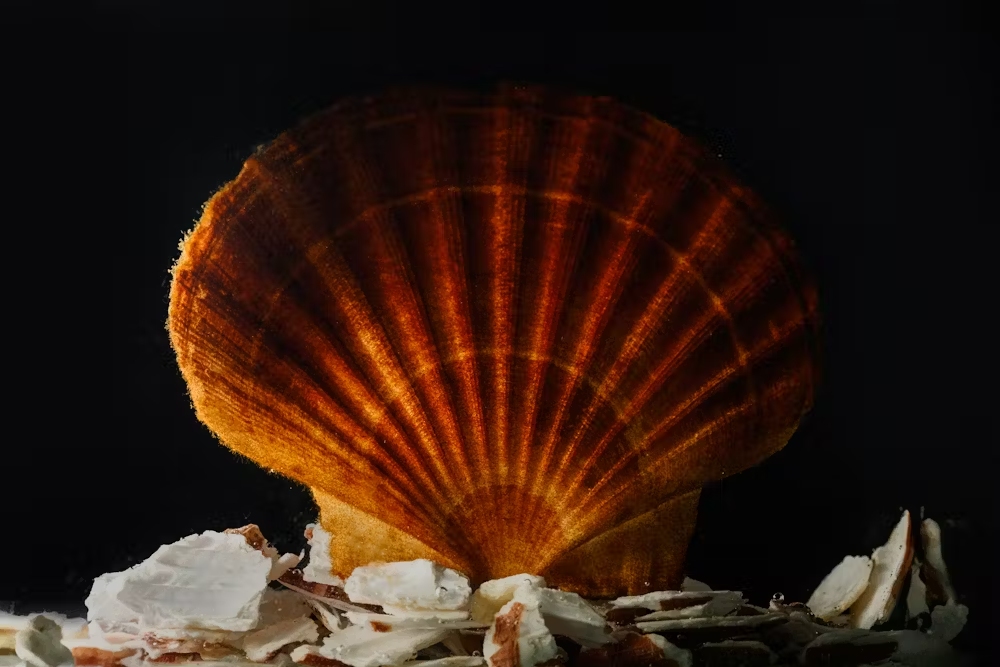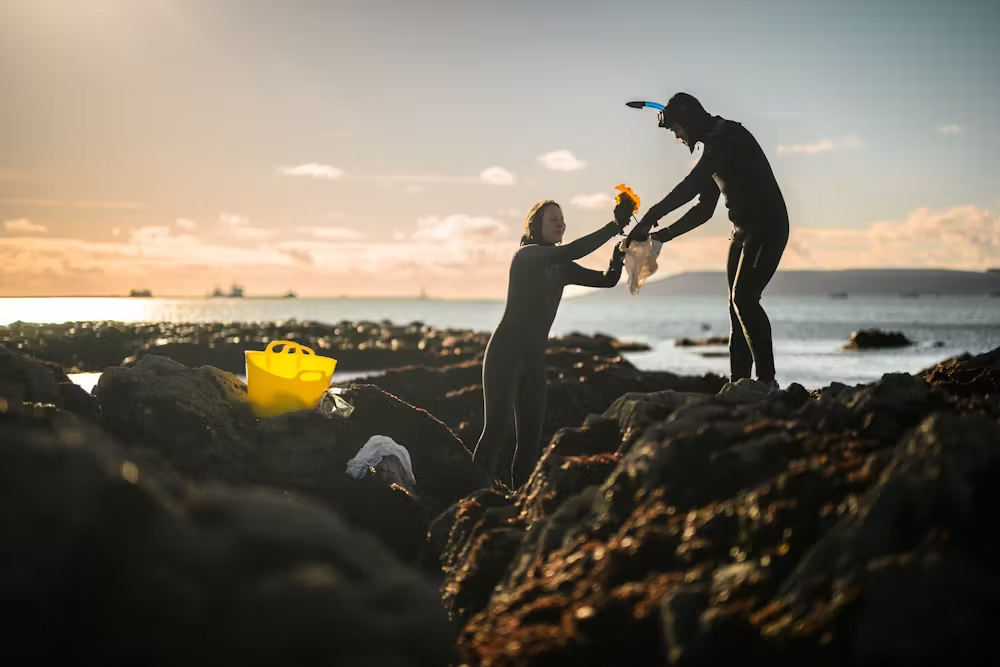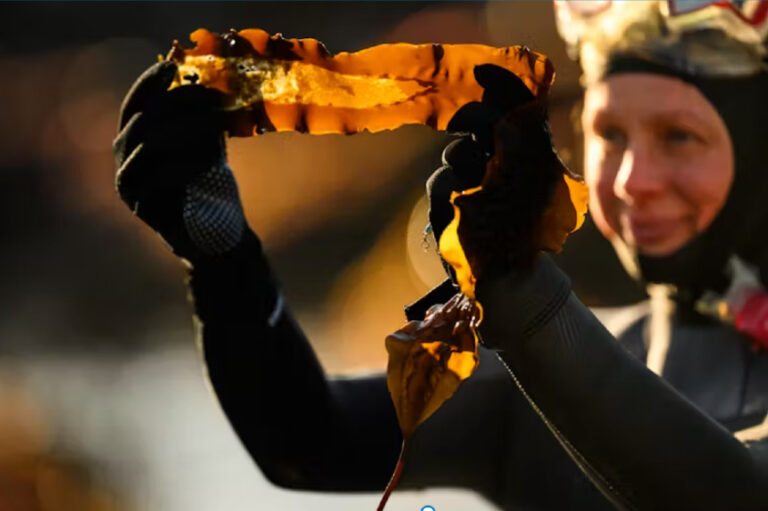This approach could restore the UK’s coastal kelp forests, say CATHERINE WILDING of the Marine Biological Association and HANNAH EARP of Newcastle University
Kelp spores are being seeded and grown on small rocks and scallop shells – a seafood waste product – in efforts to regenerate the UK’s coastal kelp forests.
Unlike many other restoration techniques, this method is cheap and easy to carry out. There’s no need for expensive, labour-intensive dive-teams to install kelp onto the seabed.
Once gravel or shells have been seeded with kelp in aquariums, teams can simply drop them over the side of a boat, where they sink, allowing the kelp to attach to the seabed where it grows to maturity. This is as effective as hand-deployment by divers and far more economical.
Our team of marine scientists is working with the Fishmongers’ Company’s Charitable Trust and the Kelp Conservation Initiative to develop this “green gravel” approach. First pioneered in Norway, green gravel techniques have previously been tested on wave-exposed shores along the north-east coast of the UK.
Now, in the lab, we are trialling waste scallop shells from the seafood industry and different types of stone from around the UK, easily sourced from hardware stores, as the basis for growing four types of native kelp.
Every year, more than 30,000 tonnes of shells go to landfill in the UK, at a cost to the industry. There’s huge potential to use shells as a restoration material at scale, either whole or crushed into smaller pieces.
From tanks to seabed trials
We begin green gravel restoration by identifying a healthy wild population of kelp with adult plants that can be used as donors. Sections of frond filled with spores are cut out and bought back to the lab, then disinfected with a quick dip in iodine solution.

Gravel or scallop shells are cleaned and put into tanks of sea water. The fertile kelp material is dried out overnight, then rehydrated to initiate the release of hundreds of millions of microscopic kelp spores. Once extracted, spores are added to tanks of seawater, where they settle to seed the gravel or shells.
Spores develop quickly, so tiny kelp seedlings are visible as a brown fuzz within three to four weeks. We monitor growth for three months then, once the kelp plants reach 1cm long, the gravel or shells are taken by boat to test sites off the coasts of Newcastle, Cornwall and Devon.
Once dropped over the side of the boat, the stones or shells quickly sink. Over time, the seaweed’s root-like ‘holdfast’ grows to attach securely to the seabed beneath.

By monitoring the growth of these kelp habitats, ideally every few months for several years, we can measure the success of this restoration method. Our early results suggest that a wide variety of UK stone types will be suitable, although success is likely to vary due to local conditions at each site.
Why restore kelp forests?
Found along almost a third of the world’s coastlines, kelp are marine algae that can form diverse ecosystems, like forests on land. People depend on the valuable goods and services they provide – from shelter for commercially valuable fish to carbon storage and coastal protection.
But these forests are threatened by warming oceans and marine heatwaves, pollution, poor water quality and overfishing. In many areas, kelp forests are shrinking or have been lost, leading to calls for restoration action.
Seven kelp species, together with other brown seaweeds, cover an area of up to 20,000sq km along the UK’s rugged coastline. Local declines have been reported in certain areas, including west Sussex and County Durham.
UK kelp forests are not exempt from the impacts of climate change and human activities. Early-warning signs include species range-shifts, with cold-adapted kelp species declining in southern England, while warm-adapted species are expanding and taking take their place.
These changes have knock-on effects in terms of how these ecosystems work, for example in the amount and quality of habitat that they provide for other species.

Restoration has been hailed as a tool to regenerate kelp forests in areas where they are shrinking or have been lost, with an array of techniques being developed around the world.
Almost 200 nations have pledged to protect 30% of the world’s oceans by 2030, while the Kelp Forest Challenge – a global initiative run by the Kelp Forest Alliance – aims to protect 4 million hectares of kelp forest by 2040.
But the UK lags behind on the international marine restoration stage, having only recently made limited progress towards restoring seagrass meadows, saltmarshes, oyster reefs and kelp beds.
Our progress over the next three years will inform kelp restoration methods through the Green Gravel Action Group that recently identified international challenges and solutions to marine-forest restoration. Our team is working out how best to adapt green gravel methods to specific locations and wave conditions in the UK.
If scalable and effective in different scenarios, this technique could provide a sustainable use for waste shells, reducing the volume sent to landfill each year nationally, while restoring crucial ocean habitats.

Don’t have time to read about climate change as much as you’d like?
Get a weekly roundup in your inbox instead. Every Wednesday, The Conversation’s environment editor writes Imagine, a short email that goes a little deeper into just one climate issue. Join the 30,000+ readers who’ve subscribed so far.
Catherine Wilding is Senior Research Assistant, Marine Ecology at the Marine Biological Association and Hannah Earp is Postdoctoral Research Associate, Marine Ecology at Newcastle University
This article is republished from The Conversation under a Creative Commons licence. Read the original article.
Also on Divernet: The Unsung Reef, Be The Champ! – Kelp Forest, Divers can help revive kelp & seagrass, Entangled in kelp by night

